Are Small Saws Kid’s saws or is There More to It?
Last week I bought a 12” handsaw with 9-ppi but not just because I wanted it, I thought you might be interested in it too. Not a serious saw? Oh, I think so. What use can that be?
To be frank, I wish that someone would make saws this size for serious users and uses. I am not a small man but I would use one. If I were small I would make one from a bigger one. It’s all too easy to say what cuts a lot cuts a little, but I can think of many people who would benefit from using one of these including more slightly built men and women, children of all ages, people like me for use at the bench, for tasks that require thinner stock. I could go on.
Well, is it a toy or is it real? Who would have used it when it was first made? What was it used for? Actually, this saw is not that old, although it is actually a serious saw in that it is spring steel, hard, tempered teeth and with teeth large enough to cut serious depth, what look like studs through the handle with a slot head for a screwdriver are nothing more than press fit; they don’t screw or unscrew at all. But this is a proper saw. The teeth tell me something too. The rake is very passive.
The saw is well used and without kinks or bends in the blade. The handle is well worn but a bit shapeless.
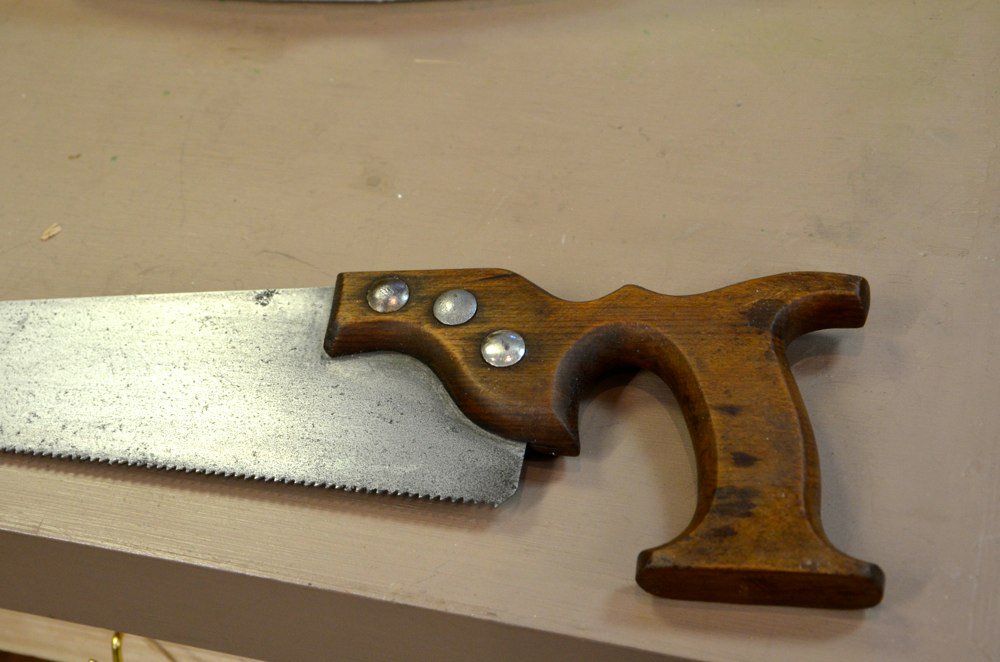
I tried the saw without further ado as soon as it arrived, as I do all saws. I want to track every detail of its past as near as I can. I do the same with planes. I look inside for shavings and traces of wood in the throat, that sort of thing. Anyway, to cut down to the line (shown below) took 52 stokes with the controlled, even, forward-thrust pressure used with western saws. Too many, but, surprisingly, the saw didn’t really balk at the work and this was because of the passive front rake. If I were to sharpen a saw for a younger woodworker I would most likely use smaller teeth or develop a lesser rake as in the case of the saw shown. Probably not so passive as this, but somewhere between this and the more fully aggressive rake I might prefer on my ripsaws.
I topped the teeth (jointed USA) to level them, which then guides me for evening them up as I reshape them to the configuration I want for the work it will be used for. Three strokes worked in this case. Filing the teeth then is a question of shape and tooth pattern.
It took three strokes to each gullet to shape the teeth enough to get to each tooth tip.
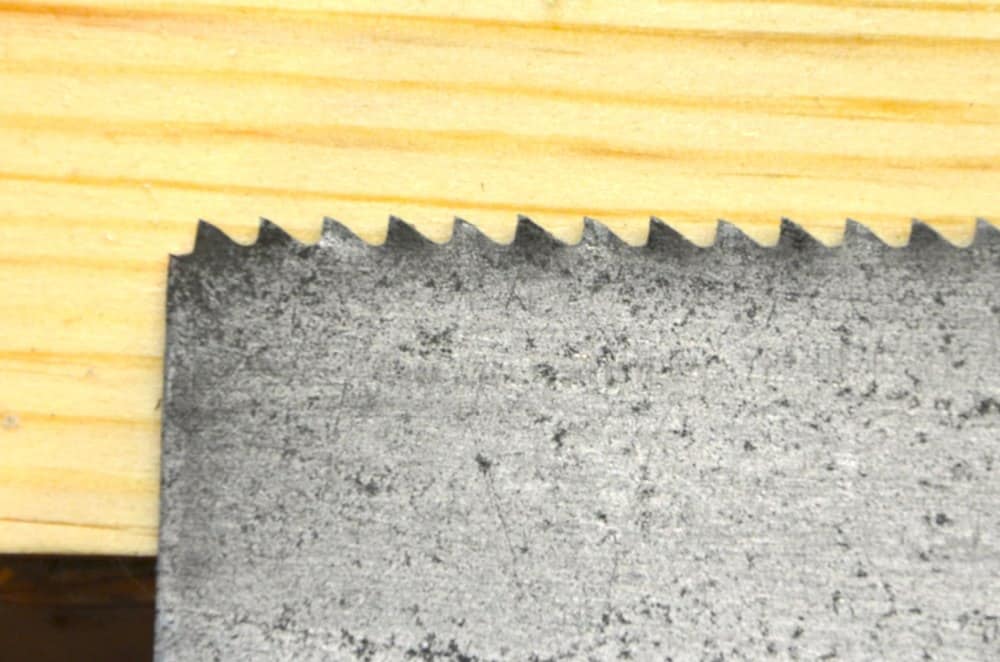
I tried the saw a second time and this then took 16 strokes to get to the line.
So, in the picture below you can see the 52 strokes when the saw was dull, The 16 strokes with reshaped teeth and the 10 strokes when the saw was finished and set.
Once this was done I added a micro back-bevel for strength and then all I needed was a little more set. I set to 20-ppi because that’s all I need for dry and thin wood.
Below: Teeth before new shaping at the toe end
Below: After shaping and sizing
Now then, just who would use a saw like this? I usually look at a saw like this as I might say a #3 plane and say to myself, “Small saw, small-statured person – perfect unity and harmony.”. It’s a good strategy that many women, men and others who are of a smaller build will find a real advantage in using smaller tools made specifically for them. Children especially need smaller sized tools that parallel their size as they grow up into the larger, more full-sized tools they need. Veritas created a smaller, bevel-up smoothing plane with this criteria in mind. I would that they or others would come up with a 12-16” handsaw.
In my experience there has always been different levels of disparity in ability levels in the ranks of woodworkers regardless of gender. That said, it is only in recent decades that woodworking has been a more open option for everyone and anyone and though those who were restricted in decades past are no longer prohibited by the same archaic dominances of old, they are often disqualified by oversized hand tools that just don’t fit for several different reasons. I would that tool makers making tools would design for new users either beginning in woodworking and for those who need smaller tools to be made for them or at least found for them.
In the Era of the Gentlemen Gent’s hand Tools Were Made
Back in the more regal and royal realms of British woodworking history, and when woodworking was a male-only craft, the ‘gentle’ men of more noble births discovered that they liked to work with their smaller-than- common-man hands; small hands, unmuscular shoulders, arms, hands and chests meant they needed smaller sized hand tools scaled to fit. They asked for and got the hand tools made for them and this included all the tools used by the stronger working men of the time; hence the term gent’s and gent’s tools. Such was the power of wealth and certain realms of dominion for the land-owning gentry. What restricts the same movement today is as always demand, the strategies and politics of economics and such like that. Perhaps in decades to unfold more favourable change will come, I doubt it, with the support to create, and proportionally sized tools will be more readily available.
I used this newly restored saw on some thinner 1/2” thick redwood pine and some 7/8” thick pine. Not tough stuff, but harder than all the pines available in the USA. It sliced very readily and as well as my longer saws, but it does of course take twice as many strokes. I’m used to full length saws twice as long and more, but I wouldn’t treat this saw as an inferior saw or kid’s stuff even if it is more than ideal for serious children’s woodworking. As I said, I think it would have been great for my children when the were young and for some of my students today.


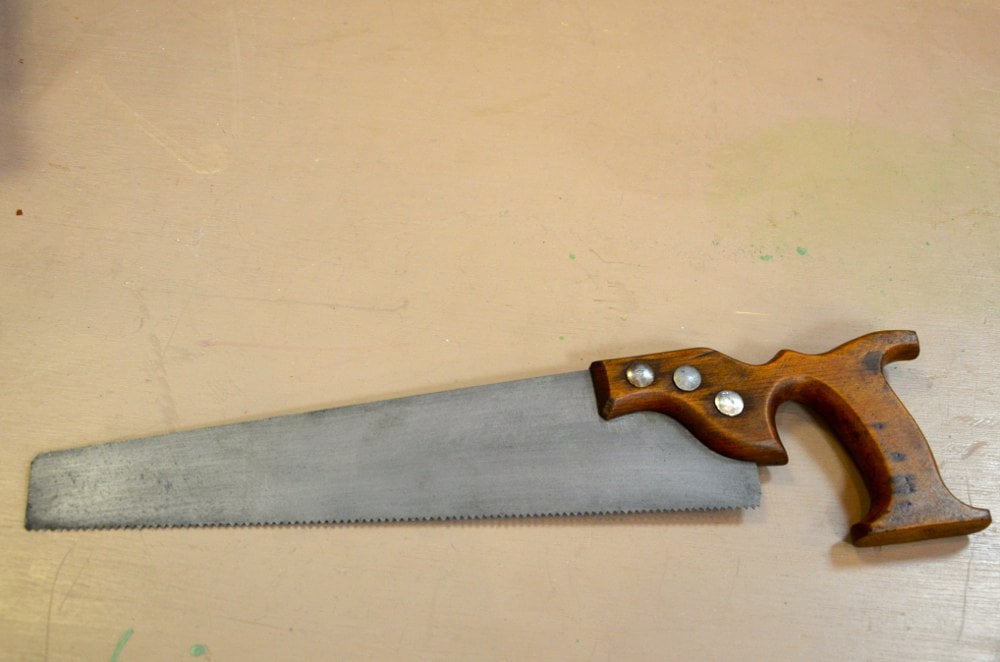


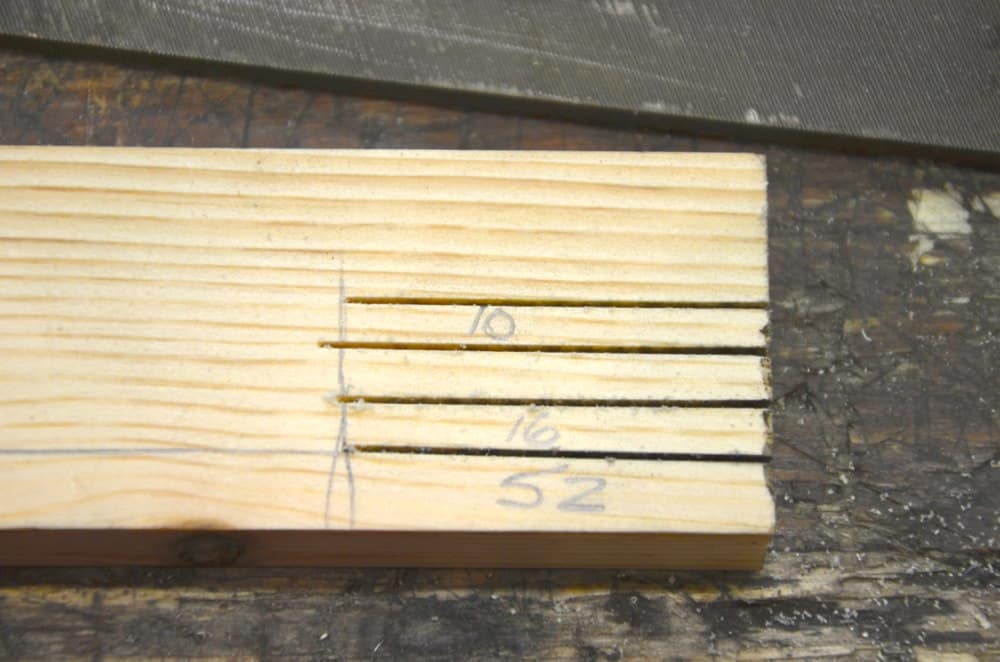
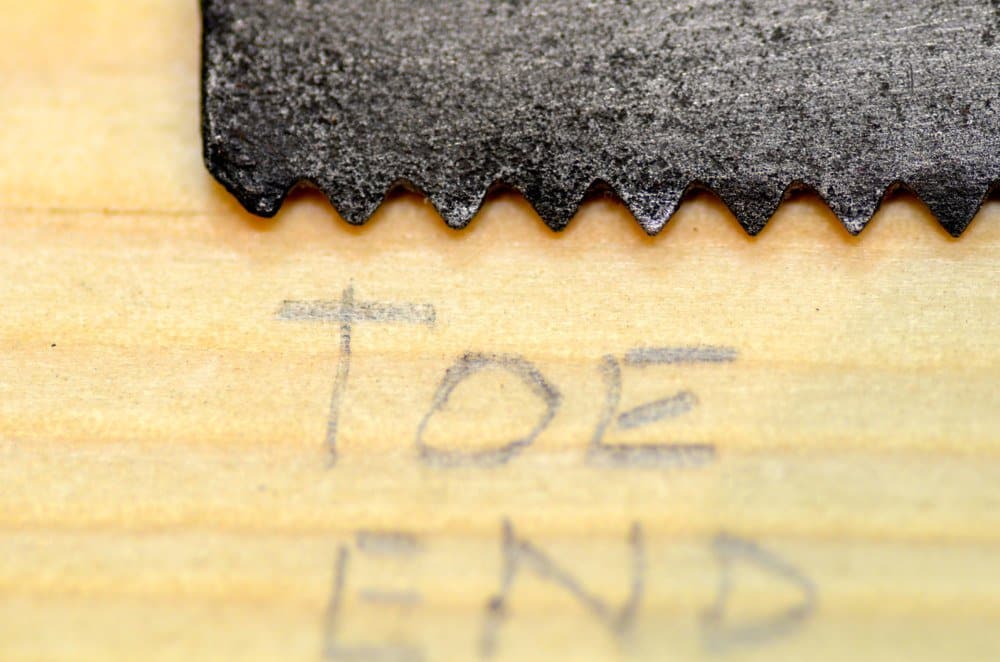
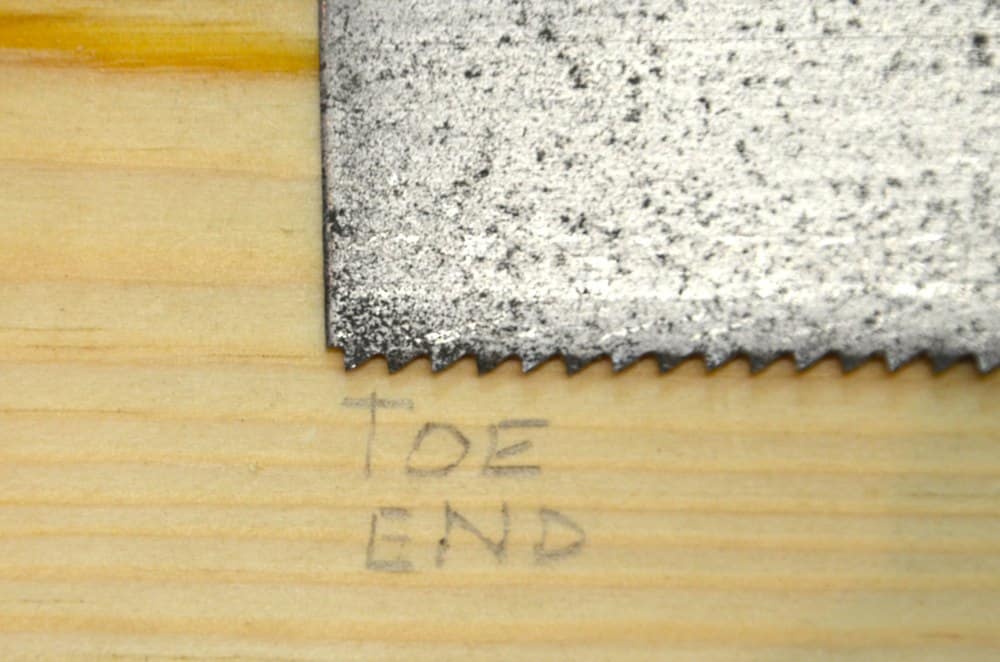

Might it be a German made saw? These kind of saws (with a sort of unrefined handle) and without a spine and proper saw nuts are often found on Ebay Germany. As on the continent mostly frame saws were used, the standard of making of hand saws was much less refined, it seems to me. Generally one hardly comes across a German made backsaw (and if you see a backsaw, the spine looks often akwardly made und quite rough compared to British saws).
here are some finds on ebay
http://www.ebay.de/itm/Alte-Sage-Handsage-Fuchschwanz-/171401119658?pt=Alte_Berufe&hash=item27e84d87aa
http://www.ebay.de/itm/2-ALTE-HANDSAGEN-DEKO-SAGEN-TISCHLER-STELLMACHER-ZIMMERMANN-D-R-G-M-GEPRAGT-/221495136904?pt=Alte_Berufe&hash=item3392239288
http://www.ebay.de/itm/3-x-Fuchsschwanz-Sage-Baumsage-Handsage-/281394647441?pt=Alte_Berufe&hash=item41846d9191
http://www.ebay.de/itm/Alte-Sage-/161375739936?pt=Alte_Berufe&hash=item2592be6020
Hi Paul,
I think I bet on a similar item last week on ebay.
Congratulation for your last purchase and thanks for sharing what can be done with a tool of this size.
Thanks,
Lucian
Very informative, but I don’t understand what the statement “I set to 20-ppi” means. Did you change the number of teeth? Wouldn’t that have required much more aggressive “topping” than three strokes? Thanks
Most topping should only take 2 or 3 strokes unless it’s been badly worked and neglected.
I think he meant he put a fine set on the teeth for a fine cut in dry wood, setting them as if they were 20-tpi, but he didn’t change the 9-ppi tooth pattern.
Thanks Ed. That’s right.
I am not sure but I think he is referring to the number on the saw set dial. So, not much set on the teeth.
Thanks Paul, as it happens this is perfect timing for me since I just acquired a 9 PPI Jackson (Disston secondary brand) 12 inch saw. I’m excited to get it cleaned up and working again!
maybe another addition to the sellers and sons range of hand tools would be a gents set of tools /or a petit range
Hi Paul,
Thanks very much for this very interesting article. I find inspiration in it to repurpose an older saw for use as an introductory saw for my 3 1/2 year old son, who enjoys making sawdust with daddy. One question, as I have never undertaken such an effort, how would you recommend resizing the old saw blade to an appropriate size? Just hack saw off the back 10 inches and attach a handle? Or should I draw out an entirely new profile? Thanks very much!
Cheers,
Derek
I’m not Paul, but I find that sawing requires some fine muscle movements and coordination that a boy as young as yours probably won’t have yet. If a child is big enough to handle a hand saw at all, then usually a 22″ panel saw is okay. If the child is especially short, then knocking a bigger saw down a little bit could help, but not as much as you might think.
I would actually consider starting him out on a small backsaw. The spine will keep the blade from buckling, and that’s a big plus for a youngster. Bad Axe Tool Works makes a backsaw especially for children now, and it works well.
You could, however, pick up a used backsaw for a fraction of the cost.
Thank you for adding this. I use a 16″ handsaw for 95% of my benchwork necessitating handsaws and find it very convenient and functional. This is because most of my work can be held in the vise and is rarely appropriate for saw horses and overhead, overhand cutting as with planks and panels.
With regards to tenon saws for children. I reserve giving advise on this because there are many back saws such as gents saws that are affordable and work well. A Zona is the most well suited for children if anyone is looking for a tenon saw. I wouldn’t really recommend a back saw for handsaw work because of the restriction of not being ably saw through cuts beyond the width of the saw. Just my thoughts.
You might find the offering from the German tool outfit, Dictum, interesting as they have a handsaw listed with either a 13″ (330mm) or a 17 3/4″ (450mm) blade.
http://www.mehr-als-werkzeug.de/product/712090/Turbo-Cut-Hand-Saw-330.htm
Interesting saw Paul. Concur with your thought about different size people being most comfortable and working best with appropriate sized tools. That’s one of the appealing things about woodworking, the best way to do a task varies from person to person according to their personal “style”.
To me it seems like there are two things to take into account – scaling the tool to the task, and scaling the tool to the user. As a ‘smaller-statured person’ I’d agree that sometimes a slightly smaller tool is more comfortable, but in most cases ‘normal-sized’ tools are just fine. Generally I’d say that choosing the right sized tool for the job is more important. Using a 26″ saw to rip 3/4″ stock vertically in the vice, is probably a bit unwieldy for anyone. I find a #3 plane useful for smaller parts and one-handed use, but would still use a #4 most of the time. A 12″ combination square can sometimes feel a bit of a stretch with small hands, so a 6″ square is a handy alternative.
As I’m sure I’ve heard Paul say, ‘you must have dominion over your tools’. If a tool feels right in your hand you have more chance of controlling it accurately and sensing the feedback it is giving you. The most telling thing is which tools you find yourself unconsciously reaching for time after time.
Well, there is more to it. Until recently, lets say the 70s off the last century every carpenter or furniture maker in school at the age of 14 in holland had one together with a 20 inch 7ppi , the small one dedicated for fine croscutting and the larger one for ripping. Both being filed with rip teeth .Most off them from a Sheffield firm called Slack&Sellars….In Brittain they were called Swallows but in Holland Duifje, wich translates as pigeon…And they are there a long time. I have a set a10 inch small one and a 18 inch ripper with a londen pattern handle from some where 1850… As engraved on them they were made from german cast steel..I restored an other one 12 inch 9 ppi and filed it a bit crosscut. I used it when I had to make some infill in a Boats sealing ( nothing straith in a boat , not even the masts) from coated masonite, a very tender stuff and I had to saw a gentle curve in it. Only a very light touch up with a blockplane was needed. A jiggsaw or even a bandsaw had made a mess of it..
Lately, I’ve been using a panel saw to cut baseboard that is too wide for my tenon saw, including cutting the straight portion of the coping. This work has changed my understanding of the panel saw and of tenon saws. In particular, I don’t think the spine on a tenon saw has much to do with its accuracy and suspect that a panel saw, or the “small saw” Paul shows here are capable of being used for good joinery and not just for children. The issue is more a matter of tpi, profile, and sharpening than whether there is a back on the saw. Sharpening 20 or more inches of saw with a fine tpi does not sound efficient, but a small saw like the one shown here could easily be filed just like a fine joinery tenon saw and then be very useful for deep cuts that tenon saws cannot make, like wide mouldings cut on a miter board or big tenons.
So many good old saws so little time.
Hi Paul,
looking at your pictures, what has happened with your progressive pitch on this one, it would be very helpfull on a saw like this?
I sharpened to get the shape first and found it worked well straight off so I left it to see how I feel in a few days. I may feel like changing it then but so far it works fine.
I got a Disston 12″ 10 TPI. It has missing teeth and needs fully redone, which I’m not up for in skill level yet, but it should be a nice tool to use in the future sometime.
Hi Paul,
First of all thanks for the tutorial and the answer about the hacksaw blades for cutting new tooth. My 8″ S&J works like a champ now and becomes the best saw I’ve ever owned.
I’m still looking for a S&J handsaw, especially the short ones, 16″-18″ long even though they are rare to find. And just saw some floor board saws available on eBay. Since they come with quite good price, and out of curiosity, I was wondering if these saws work equally well as the shorter S&J handsaws?
I note the lovely use of the past subjunctive tense in Paul’s writing “(I would that…). This is as beautiful as the woodworking insights here.